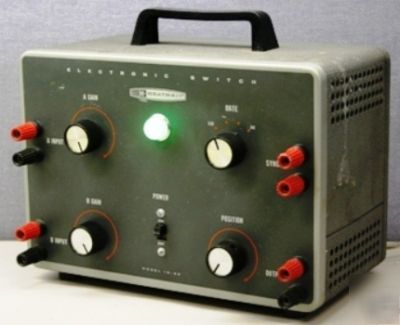____________________ > Auburn
> System components
> New Style
> Tools
> Hand tools
> Heathkit id-22 electronic switch vintage
Heathkit id-22 electronic switch vintage
Heathkit ID-22 Electronic Switch for Dual-Trace Scope Display VINTAGE
* All-electronic switching circuit no moving parts
* Broad frequency response actual signal gain through circuit
* Will function at signal levels as low as 0.1 volt
* Convenient location of controls and terminals
The Electronic Switch ID-22 came on the market in 1964 and was produced until 1970. It was the successor of the S-3 that came on the market in 1956. There is only minor differences between the S-3 and the ID-22. In 1971 the ID-22 was replaced by the ID-101, which in turn was replaced by the ID-4101 in 1977. The ID-22 makes the oscilloscope dual channel. At the time most oscilloscopes was only single channel so it came in handy. A disadvantage is that it reduces the bandwith.
Oscilloscope owners will appreciate the fine advantages provided by the S-3, in permitting simultaneous observation of two signals on the scope screen. The model S-3 will accommodate two signals and alternately produce either one to the output terminals. The alternation of one signal to the other may be made at any of four switching rates selected by a panel switch. Switching rates are approximately 150, 500, 1500 and 5000 cycles determined by four wide-tolerance condensers. A rate can be selected that is harmonically different from the signal frequency to prevent both the signal and the switching pulse from appearing statically on your scope screen. The circuit employs seven miniature tubes which also provide gain for the input signals. Circuit will function at signal levels as low as 0.1 volt. Frequency response is 1 db from 0 to 100 kc. A position control is provided so that the traces may be separated or made to superimpose on each other on the oscilloscope screen for comparison purposes. Separate gain controls are provided for each channel as well as sync output terminals to lock the oscilloscope sweep or time base to the signal frequency. The output terminals are shunted by a condenser to reduce switching transients. All controls are located on the front panel as well as the input and output terminals utilizing the Heath five-way binding post. The S-3 is easy to build with clear instructions provided and is a pleasure to use.
* Switching Rates: Approximately 150, 500, 1500 and 5000 cycles
* Signal Frequency Response: 1 db 0-100 kc
* Input Impedance: 100 Kohm control
* Output Impedance: 1000 ohms shunted by 1000 uuf
* Maximum Signal Output: 25 volts peak-to-peak
* Maximum Signal Gain: 5 times
* Tube Complement: 2-12AX7, 3-12AU7, 1-6C4, 1-6X4
* Power Requirements: 105-125 V, 50-60 cycles AC, 30 watts
* Dimensions: 9 " wide x 6 " high x 5" deep
* provides dual-trace scope presentation permitting display of two separate signals on CRT screen
* Displays signal levels as low as 0.1 volt
* Separate gain controls for each channel
* Switching rates: 150, 500, 1500, and 5000Hz
* Sync output to control scope sweep
* LETS YOU VIEW TWO SIGNALS AT ONCE. For example, simultaneously observe a signal or waveform at both the imput and output of an amplifier. A position control adjusts the separation of the two presentations allows the two signals to be superimposed for comparison purposes. Just connect the signal source test leads to the ID-22 input terminals and the ID-22 output and sync out to the oscilloscope. Both signals are then shown alternately at any one of four switching rates, appearsing simultaneously through persistence of the CRT phosphor.

